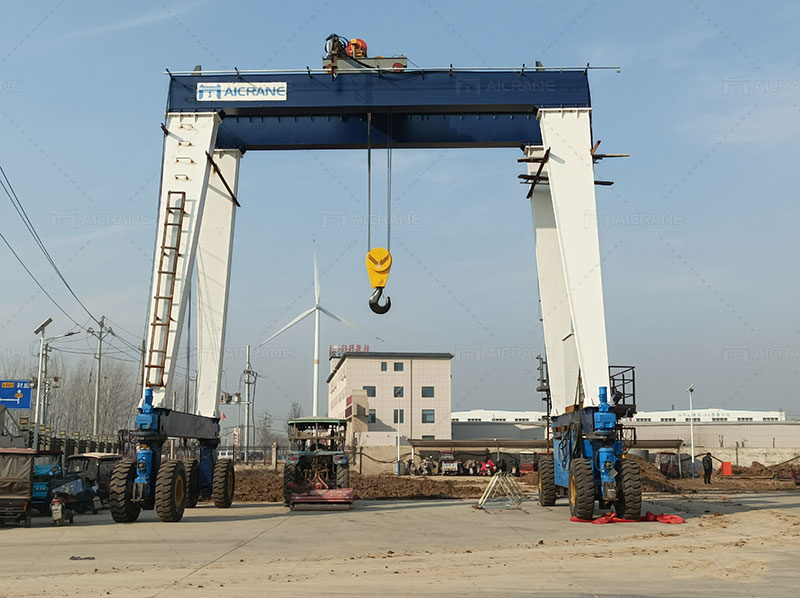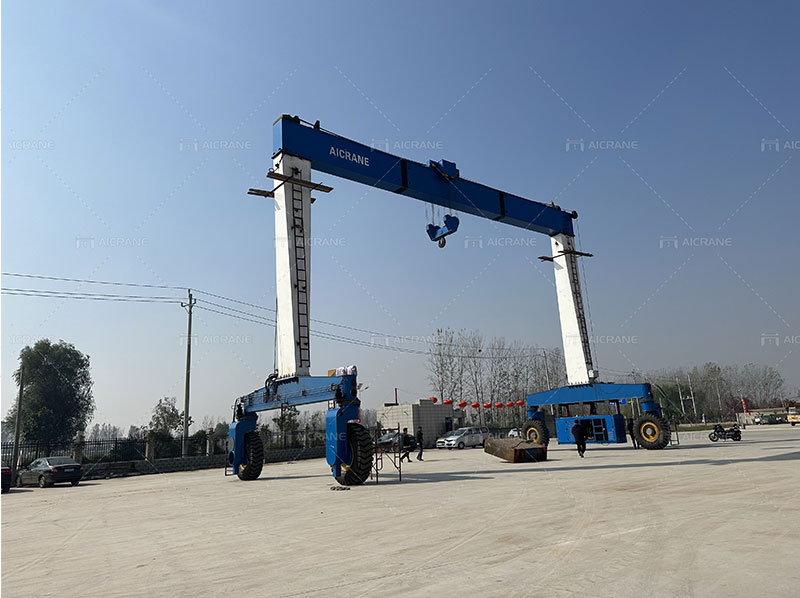When it comes to the design and operation of Rubber Tyred Gantry (RTG) cranes, one crucial component that plays a significant role in both performance and cost is the steering system. The steering system not only dictates the maneuverability and efficiency of the crane but also has a direct impact on its overall price. In this article, we will explore how the steering system of an RTG crane affects its pricing, from the basic concepts to the technical intricacies, and why understanding these differences is essential for making an informed purchasing decision.
What is an RTG Crane and Why is the Steering System Important?
RTG cranes are a type of mobile gantry crane for sale commonly used in container ports for the loading and unloading of containers from trucks and ships. These cranes are mounted on rubber tyres, which allow them to move freely within the yard without being confined to a rail system. The ability to move in different directions and handle containers efficiently is made possible by the steering system.
In an RTG crane, the steering system controls the movement of the wheels, allowing the crane to navigate tight spaces and adjust its position as required. The system determines how effectively the crane can be maneuvered, which directly impacts the speed of operations, fuel consumption, and, ultimately, the crane’s overall cost.

Types of Steering Systems in RTG Cranes
There are several different types of steering systems used in RTG cranes, each with its own advantages and disadvantages. Understanding the differences between them is essential, as the type of steering system can significantly affect the RTG crane price.
1. Conventional Steering System
The conventional steering system is the most basic and traditional form of steering in RTG cranes. This system uses a mechanical linkage to connect the steering wheel to the front wheels of the crane, enabling the operator to control the movement of the crane manually. The steering is usually done with a single or double-axle setup, which allows for steering in a single direction.
Impact on Price: While the conventional system is generally cheaper to manufacture, it comes with limitations in terms of maneuverability. The simplicity of the system keeps the initial gantry crane price relatively low. However, the drawbacks in operational efficiency and maneuverability, especially in tight spaces, may increase operational costs over time.
2. Independent Wheel Steering System
In an independent wheel steering system, each wheel on the RTG crane is equipped with its own motor and can be steered independently. This type of system allows for much greater maneuverability and precision, as each wheel can turn in different directions. The steering can be adjusted for optimal movement, particularly in situations where the crane needs to navigate tight spaces or change direction quickly.
Impact on Price: The independent wheel system is more expensive than the conventional system due to the added complexity of the technology, including motors, controllers, and sensors. The ability to steer each wheel individually provides a substantial increase in the crane’s flexibility, which may justify the higher cost for customers who require maximum efficiency in confined spaces or high-density operations.
3. All-Wheel Steering System
An all-wheel steering system allows all four wheels of the RTG crane to turn simultaneously in the same direction, providing a higher level of maneuverability. This type of system is especially beneficial in areas with high traffic, where space is limited. It enables the crane to navigate in tight turns without needing to reverse or make large adjustments, thus reducing the overall time spent positioning the crane.
Impact on Price: The all-wheel steering system is typically more expensive than both the conventional and independent wheel systems. This is due to the added complexity in design and the need for sophisticated control systems. However, the added maneuverability and the time-saving benefits often justify the increased price, especially for busy container yards or ports with limited space for crane movement.

4. Crab Steering System
The crab steering system is unique in that it allows the crane to move diagonally, as the wheels are set at an angle to one another. This type of steering system is typically used in large, heavy duty gantry crane, where the ability to move sideways without turning in place is a major advantage. The crab steering system makes it easier to position containers precisely and navigate complex routes, especially when there are obstacles or tight turns.
Impact on Price: Crab steering systems are one of the more expensive options due to the advanced technology required to implement the system. The system typically requires specialized hydraulic components and more intricate electronics to control wheel movement. Despite the higher initial cost, the crab steering system can increase operational efficiency and reduce the need for crane repositioning, thus enhancing the return on investment (ROI) over time.
5. Hybrid Steering System
A hybrid steering system combines elements of different types of steering systems, such as combining all-wheel and independent wheel steering. This system can provide operators with the flexibility to switch between different steering modes, depending on the operational requirements. For instance, it may allow for all-wheel steering in open areas and independent wheel steering for precise movements in confined spaces.
Impact on Price: The hybrid steering system is typically the most expensive option due to the added complexity and customization required. However, the versatility it offers can be invaluable for large ports or operations that require flexibility and efficiency across a wide range of tasks. The higher price can be justified by the increased productivity and efficiency gains.
The Role of Steering System in Operational Efficiency and Cost
The type of steering system chosen for an RTG crane has a profound effect on the crane’s operational efficiency, which in turn impacts its overall cost. Here are some key factors to consider:
1. Maneuverability
Maneuverability is one of the most critical aspects of an RTG crane’s performance. Cranes equipped with advanced steering systems, such as independent wheel or crab steering, offer superior maneuverability in confined spaces. This translates into reduced repositioning time and increased throughput, ultimately improving the crane’s performance in busy ports.
Cranes with more basic steering systems may struggle in tight spaces, resulting in longer cycle times and a higher cost per operation. Therefore, businesses operating in high-density areas may find the extra expense of advanced steering systems worthwhile in terms of increased productivity.
2. Fuel Efficiency
Advanced steering systems can also contribute to improved fuel efficiency. By enabling the crane to make more precise movements, these systems reduce unnecessary travel, which helps conserve energy and lower fuel consumption. For example, an all-wheel or independent wheel system allows the RTG crane to navigate more efficiently, reducing the amount of time the crane spends moving to the next load.
3. Maintenance and Downtime
A more complex steering system typically requires more maintenance and is more prone to mechanical issues. The added components such as motors, hydraulic systems, and controllers in advanced steering systems increase the likelihood of system failures and the associated downtime. This is a consideration that can add to the total cost of ownership.
On the other hand, simpler systems such as the conventional steering may require less maintenance and be more robust, but they may not offer the same level of operational efficiency.
4. Customizability
Different ports and businesses have different needs, and a customizable steering system can often provide the best fit. Hybrid and advanced steering systems can be tailored to suit the unique requirements of a particular facility, which can result in better optimization of space, time, and resources. Although they come with a higher price tag, the long-term benefits of a custom solution can far outweigh the initial investment.
Conclusion
The steering system is a key factor that directly impacts the price of an RTG crane. From basic conventional systems to advanced all-wheel or crab steering systems, the choice of steering mechanism will affect both the operational efficiency and the overall cost of the crane. While more advanced steering systems generally come at a higher price, their benefits in terms of maneuverability, fuel efficiency, and long-term productivity can make them well worth the investment for high-density operations or ports with limited space.
For businesses looking to optimize their operations, it is important to carefully assess the type of steering system that best aligns with their specific needs and budget. The right choice can lead to significant improvements in both performance and cost-effectiveness, ensuring the best return on investment for the RTG crane.